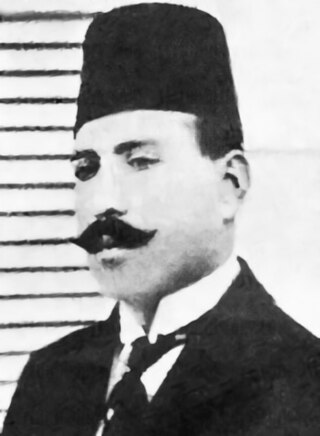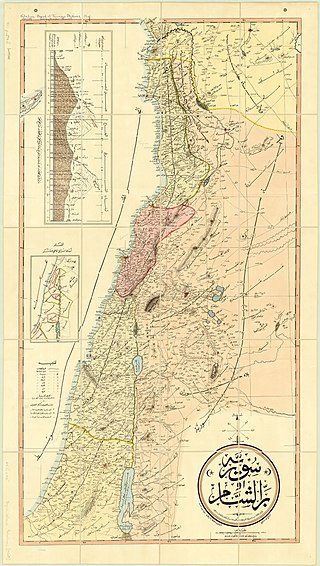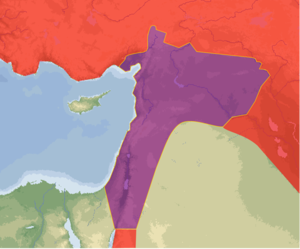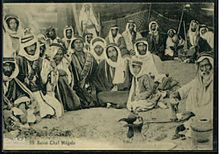
Al-Karak, is a city in Jordan known for its medieval castle, the Kerak Castle. The castle is one of the three largest castles in the region, the other two being in Syria. Al-Karak is the capital city of the Karak Governorate.

As-Salt, also known as Salt, is an ancient trading city and administrative centre in west-central Jordan. It is on the old main highway leading from Amman to Jerusalem. Situated in the Balqa highland, about 790–1,100 metres above sea level, the city is built in the crook of three hills, close to the Jordan Valley. One of the three hills, Jabal al-Qal'a, is the site of a 13th-century ruined fortress. It is the capital of Balqa Governorate of Jordan.

The Hauran is a region that spans parts of southern Syria and northern Jordan. It is bound in the north by the Ghouta oasis, eastwards by the al-Safa field, to the south by Jordan's desert steppe and to the west by the Golan Heights. Traditionally, the Hauran consists of three subregions: the Nuqrah and Jaydur plains, the Jabal al-Druze massif, and the Lajat volcanic field. The population of the Hauran is largely Arab, but religiously heterogeneous; most inhabitants of the plains are Sunni Muslims belonging to large agrarian clans, while Druze form the majority in the eponymous Jabal al-Druze and a significant Greek Orthodox and Greek Catholic minority inhabit the western foothills of Jabal al-Druze. The region's largest towns are Daraa, al-Ramtha and al-Suwayda.
The al-Atrash, also known as Bani al-Atrash, is a Druze clan based in Jabal Hauran in southwestern Syria. The family's name al-atrash is Arabic for "the deaf" and derives from one the family's deaf patriarchs. The al-Atrash clan migrated to Jabal Hauran in the early 19th century, and under the leadership of their sheikh (chieftain) Ismail al-Atrash became the paramount ruling Druze family of Jabal Hauran in the mid-19th century, taking over from Al Hamdan. Through his battlefield reputation and his political intrigues with other Druze clans, Bedouin tribes, Ottoman authorities and European consuls, Ismail consolidated al-Atrash power. By the early 1880s, the family controlled eighteen villages, chief among which were as-Suwayda, Salkhad, al-Qurayya, 'Ira and Urman.

Sultan al-Atrash,, commonly known as Sultan Pasha al-Atrash was a prominent Arab Druze leader, Syrian nationalist and Commander General of the Syrian Revolution (1925–27). He fought against the French. One of the most influential figures in Syrian and Druze history, he played a major role in deciding the destiny of Jabal al-Druze and of Syria in general.

The Hauran Druze Rebellion was a violent Druze uprising against Ottoman authority in the Syrian province, which erupted in 1909. The rebellion was led by the al-Atrash family, in an aim to gain independence, but ended in brutal suppression of the Druze, significant depopulation of the Hauran region and execution of the Druze leaders.
The 1838 Druze revolt was a Druze uprising in Syria against the authority of Ibrahim Pasha and effectively against the Egypt Eyalet, ruled by Muhammad Ali. The rebellion was led by Druze clans of Mount Lebanon, with an aim to expel the Egyptian forces, under Ibrahim Pasha considering them as infidels. The revolt was suppressed with a bitter campaign by Ibrahim Pasha, after a major Druze defeat in the Wadi al-Taym, and the Egyptian rule effectively restored in Galilee and Mount Lebanon with a peace agreement signed between the Egyptians and Druze leaders on July 23, 1838. Among the major sites of violence was the city of Safed, where the Jewish community was attacked by Druze rebels in early July 1838.
Busra al-Harir is a town in southern Syria, part of the Daraa Governorate situated in the Hauran plain. It is located northeast of Daraa and northwest of as-Suwayda. Nearby localities include Maliha al-Atash to the southeast, al-Shaykh Maskin to the east, Izra to the northeast, Harran to the northwest, Najran to the west, al-Mazraa to the southwest and Nahitah to the south. In the 2004 census by the Central Bureau of Statistics (CBS) Busra al-Harir had a population of 13,315.
Al-Mazraa, also known as as-Sijn is a village in southeastern Syria, administratively part of the as-Suwayda Governorate, located 12 kilometers northwest of as-Suwayda. Nearby localities include al-Hirak, Khirbet Ghazaleh and Da'el to the west and Umm Walad and Bosra to the south. According to the Syria Central Bureau of Statistics (CBS), al-Mazraa had a population of 2,596 in the 2004 census. The town is also the administrative center of the al-Mazraa nahiyah of the al-Suwayda District which consists of 12 villages with a combined population of 16,627.
Umm Walad is a town in southern Syria, administratively part of the Daraa Governorate, located east of Daraa in the Hauran region. Nearby localities include Ira to the southeast, Jabab to the south, al-Musayfirah to the southwest, al-Karak to the northwest, al-Thaalah to the north and al-Suwayda to the northeast. According to the Syria Central Bureau of Statistics (CBS), Umm Walad had a population of 7,547 in the 2004 census.

Al-Shaykh Saad, historically also called Karnaim and Dair Ayyub, is a town in southern Syria, administratively part of the Daraa Governorate, located northwest of Daraa on the Jordan–Syria border. Nearby localities include Nawa, Jasim and al-Harrah to the north, Izra and al-Shaykh Maskin to the east, Tafas and Da'el to the southeast, and Adwan and Tasil to the west and Jalin to the southwest. According to the Syria Central Bureau of Statistics, al-Shaykh Saad had a population of 3,373 in the 2004 census.
Al-Qurayya is a town in southern Syria, administratively part of the al-Suwayda Governorate, located south of al-Suwayda. Nearby localities include Bosra to the southwest, Hout to the south, Salkhad to the southeast, al-Kafr, Hibran and Sahwat al-Khudr to the northeast, Sahwat Bilata and Rasas to the north and 'Ara and al-Mujaymer to the northwest. According to the Syria Central Bureau of Statistics (CBS), al-Qurayya had a population of 6,789 in the 2004 census. The town is also the administrative center of the al-Qurayya nahiyah which consists of four towns with a combined population of 9,892.

Al-Musayfirah is a town in southern Syria, administratively part of the Daraa Governorate, located east of Daraa and 37 kilometers southeast of Damascus. Nearby localities include Kahil to the southwest, al-Jiza to the south, al-Sahwah to the southeast, 'Ara to the east, Umm Walad to the northeast, al-Karak to the north, al-Ghariyah al-Sharqiyah to the northwest and Saida to the west. Al-Musayfirah has an area of 705 hectares. According to the Syria Central Bureau of Statistics, al-Musayfirah had a population of 10,466 in the 2004 census. It is the administrative center of the al-Musayfirah nahiyah ("subdistrict") which consisted of four localities with a collective population of 32,473 in 2004. In recent times its population was estimated to be about 13,600 in 2009. Its largest family is the al-Zu'bi (al-Zoubi) clan.

Nasib al-Bakri was a Syrian politician and nationalist leader in the first half of the 20th century. He played a major role in establishing al-Fatat, an underground organization which sought the independence and unity of the Ottoman Empire's Arab territories. As the chief envoy between al-Fatat and the Hejaz-based Hashemites, al-Bakri became a close aide to Emir Faisal when the latter became King of Syria following the success of the 1916 Arab Revolt. Al-Bakri opposed the establishment of the French Mandate of Syria and became one of the chief commanders of the Great Syrian Revolt, leading the rebels' brief capture of Damascus. He escaped a death warrant in Syria in 1927, but returned the following year after being amnestied.

Mehmed Rashid Pasha was an Ottoman statesman who served as the vali (governor) of Syria Vilayet in 1866–1871 and as minister of foreign affairs of the Ottoman government in 1873–1874 and 1875 until his death. Rashid Pasha was raised in Egypt where his father was an aide of the governor Muhammad Ali and was educated in Paris before joining government service in Istanbul in 1851. There he became a protege of the grand vizier Ali Pasha, a key figure in the empire-wide Tanzimat reforms. After the latter was reappointed grand vizier in 1866, Rashid Pasha was appointed governor of the Damascus-centered Syria Vilayet which extended from Tripoli and Hama in the north to Palestine and Transjordan in the south.

Siege of Al-Karak was a 17-day siege imposed by Ibrahim Pasha of Egypt on the Transjordanian town of Al-Karak in 1834. The Pasha laid the siege on the town in pursuit of Qasim al-Ahmad, the leader of the Peasants' revolt in Palestine, who had fled from Nablus to take shelter in Al-Karak.

The Shoubak revolts were a series of uprisings against Ottoman authority in the Transjordanian town of Shoubak that took place in 1900 and 1905. The second uprising started after the Ottoman forces started to put women of the town into forced labor, considered to be a deliberate act of punishment against the inhabitants of Shoubak who were frequently insubordinate. Shoubak rose in revolt and managed to rally the neighboring Bedouins with them; the perpetuators were brutally punished by military force through an Ottoman expedition sent from Al-Karak, just north of Shoubak.

The Syrian Peasant Revolt was an armed uprising of Levantine peasant classes against the rule of Ibrahim Pasha of Egypt in 1834–35. The revolt took place in areas of Ottoman Syria, at the time, ruled by the semi-independent ruler of Egypt, who conquered the region from loyal Ottoman forces in 1831.
The Alawite revolt, also known as the Nusayri rebellion, was one of the arenas of the Syrian Peasant Revolt (1834–1835). Between 1834 and 1835, the Alawites (Nusayris) rose up against Egyptian rule of the region, while pro-Egyptian governor of Homs Salim Beg and the forces of Emir Bashir Shihab II of the Mount Lebanon Emirate, commanded by Khalil and his relatives, participated in the suppression of revolts in Akkar, Safita, the Krak des Chevaliers and an Alawite revolt in the mountainous region of Latakia.

Establishment of the Emirate of Transjordan refers to the government that was set up in Transjordan on 11 April 1921, following a brief interregnum period.
















